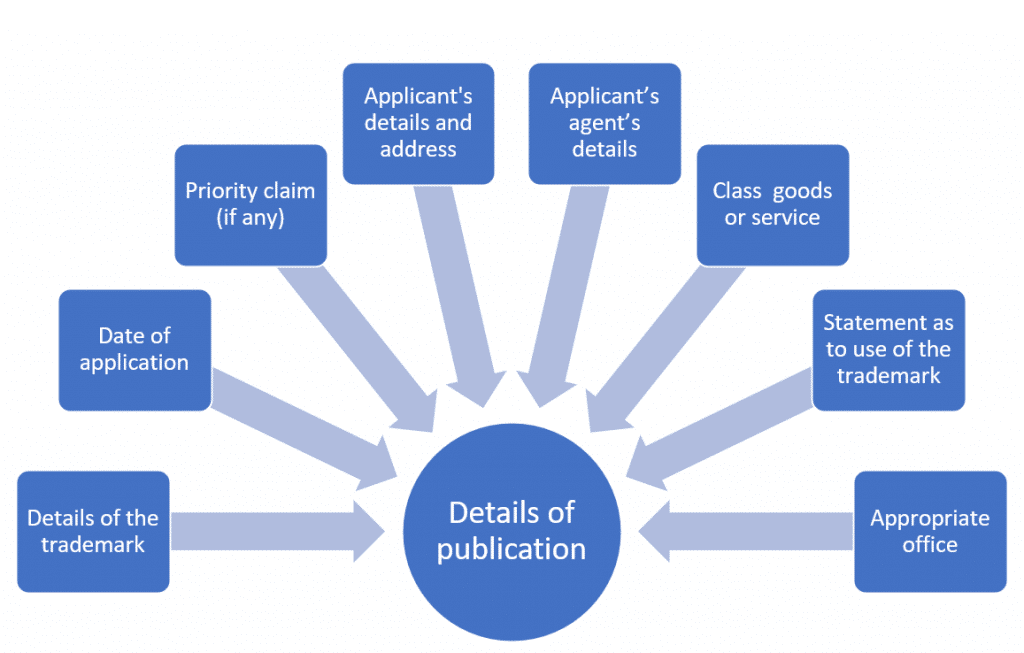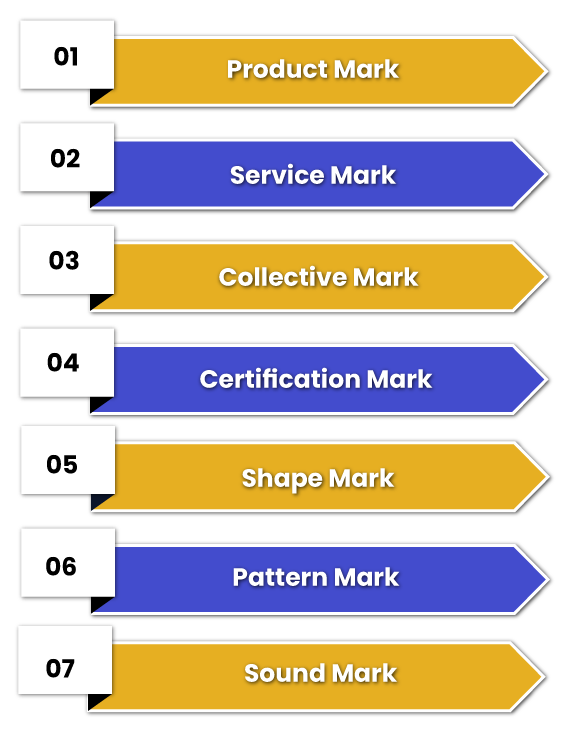The Indian Trademark Registry publishes information about trademark applications and registrations in The Trademark Journal of India, a public record. It includes information about the trademark's goods or services covered, the applicant's name and address, the application or registration number, and any oppositions or objections lodged against the trademark. The magazine promotes transparency and makes it possible for interested parties to keep track of the progress of trademark registrations and applications.
The trademark that has not been subject to objection by the Trademark Examiner in the examination report and has been approved forms an entry in the Trademark Journal, a government publication.
The Trademark Journal is a journal containing the trademarks that are registered or in the process of getting registration. The journal is published regularly and available in print and soft copy. It is a public document that anyone can access and review and, if required, may show objection.
Did You Know? The Trademark Journal is a weekly update about trademarks accepted and published by the Trademarks registry. This journal is publicly available on the Trademark Registry website www.ipindia.nic.in.
What is a Trademark Journal?
A trademark journal contains details about any modifications to registered trademarks, such as ownership transfers or assignment changes. It also details any filed oppositions or disputes raised by any party concerned.
The Trademark Journal of India is a valuable resource for companies, trademark attorneys, and other interested parties that want to keep updated on the trademarks that are getting registration in India.
It can be used to conduct trademark searches to determine whether a specific trademark is accessible and to look for potential trademark disputes. It is also helpful in tracking changes in India's trademark environment and rival activity.
A trademark must be distinctive and not confusingly similar to any already registered trademarks in India to be eligible for registration.
Also Read: Ropes, Sacks, and Bags: The Ultimate Guide to Trademark Class 22

Particulars of the Publication
The Trademark Journal is published under the following particulars or headings for a newly registered trademark for constructive notice of the General Public -
- Details of the applicant and his address
- Details of the trademark
- Appropriate office
- Class & specification of goods or service
- Statement as to use of the trademark
- Applicant’s address for service, including his agent’s detail
- Priority claim (if any)
- Statement as to use of the trademark

Every Monday, the Trademark Registry's Head Office publishes the Trademark Journal. The Trademark Registrar website offers free access to trademark periodicals.
Trademark Journals contain the following details:
- Any public notice issued by the trademark office.
- A trademark application that has been accepted or is in the process of getting approval.
- Corrigenda or any other publication in response to previous journal entries.
- The trademarks are newly registered, renewed, or any withdrawal from the journal or removal, if any.
- Republication of any entry, if any, ordered by a competent officer.
- Any assignments or transmission records, if any, post-registration.
- As Published by the World Trade Organisation, any international non-proprietary names.
- Occasionally, any other relevant information is considered of public interest.
Also Read: Ultimate Guide for Trademark Class 11 - Lighting, Heating and Cooking Appliances
Different Types of Trademarks That May Be Registered in India
Here are different types of trademarks that can be registered in India:
- Any name (including the applicant's or predecessor's in business's personal or surname, or the person's signature) commonly used in trade as a mark.
- A letter or number in any order or combination
- Fancy or a device name
- Monograms
- An invented word or words from a dictionary that is not directly descriptive of the character or quality of the goods/service.
- The right to trademark ownership can be obtained through registration under the Act or use for specific goods or services.
- Sound marks are graphically represented when they are represented in conventional notation or described in words.
- The appearance of goods or their packaging.
- Marks that form three-dimensional signs.
- A colour combination or even a single colour combined with a word or device.

How to Access the Trademark Journal?
You can access the Trademark Journal by following these steps -
- Click on this link: https://search.ipindia.gov.in/IPOJournal/Journal/Trademark

- Click on the desired journal from the Trade Marks Journal on the page.
- Click on the “Find” option.
- Enter the Key Words for Application Number / Class / Address / Abstract.
- To refine the Search, follow the procedure mentioned in step 4.
Why is a Trademark Journal Important?
Why Trademark Journal is important:
- Public Opposition: The journal plays a significant role since the public can apply for opposition to trademark registration when published in the journal.
- Renewal of Trademarks: Trademark owners can also learn about renewing a trademark registration certificate from the Trademark Journal.
- Prevention of Infringement: All registered trademark owners should also check the Trademark Journal for any potential overlapping trademarks with their registered trademark. By checking the Trademark Journal, infringement and brand dilution can be prevented.
Also Read: Ropes, Sacks, and Bags: The Ultimate Guide to Trademark Class 22
Benefits of Registering a Trademark
There are several benefits to registering a trademark.
- Brand recognition: A registered trademark can help you create your brand, increase consumer awareness, and foster goodwill. This may be crucial if your company is small or expanding.
- Investment value: A registered trademark may have an investment worth for your company. It can be used as collateral for loans, licensed to others for a fee, or even sold outright if your business is sold.
- Increased credibility: A registered trademark can help establish your business as a professional and credible entity.
- Protection: Registered trademarks are easier to defend than unregistered ones. This is because registered trademarks are public information that can be easily looked for and verified. This may make it simpler to file a lawsuit if required.
- International protection: A registered trademark might offer protection in other nations if you intend to grow your business worldwide. If you want to enter markets with various legal systems where it can be more challenging to protect your rights, this can be very crucial.
Steps to Register a Trademark in India
The steps to register a trademark in India are as follows:
Step-1: Check for Availability
To determine if the trademark you intend to register is already in use, browse the Indian Trademarks Office database. This can assist in locating any potential trademark problems.
Step-2: Get the Application Ready
Fill out the trademark application form entirely and gather any necessary supporting documentation. This includes a duplicate of the trademark and a list of the products or services it will be used for.
Step-3: File the Application
Send the Indian Trademarks Office the finished application, the required payments, and the supporting paperwork.
Step-4: Examining and Reviewing
The TM Office will check the application to ensure it complies with all regulations. This can entail corresponding with the applicant to address questions or solicit more details.
Step-5: Publication
The trademark will be published in the Trademark Journal of India if the application is approved. This permits a 30-day window for any interested party to file an opposition to the trademark registration.
Step-6: Registration
The trademark will be registered, and the registration will be noted in the Trademark Journal of India if no opposition is submitted or any opposition is unsuccessful. The applicant will be given a registration certificate.
The TM Office carefully examines each trademark application within the set timeframe to ensure it complies with the various requirements. If a trademark application is accepted, it is published in the Indian Trademark Journal and subject to objection for 30 days.
Any interested party may submit an opposition to the trademark registration during this time. The trademark is registered, and the registration is entered in the journal if no opposition is made or any opposition is lodged but is unsuccessful.
Conclusion
The Indian Trademarks Office publishes the Trademark Journal of India and contains information on trademarks registered to, assigned to, or applied for in India. The application may, however, may, not be approved. It is a public record that anybody can occasionally inspect and raise public objections if needed.
Applying to the Indian Trademarks Office, searching to ensure that the desired trademark is available for use, and through a review and inspection process are all required steps in trademark registration in India.
After the application is approved, the trademark will be published in the Indian Trademark Journal and open to opposition for 30 days. Legal protection, brand recognition, investment value, greater credibility, and the capacity to protect property globally are all advantages of trademark registration.
Follow Khatabook for the latest updates, news blogs, and articles related to micro, small and medium enterprises (MSMEs), business tips, income tax, GST, salary, and accounting.

